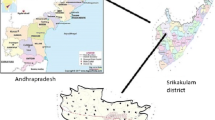Abstract
The water quality index (WQI) is an important tool to determine the drinking water quality in urban, rural and industrial area. WQI is defined as an index reflecting the composite influence of different water quality parameters which is considered and taken for calculation of water quality index. In the present study, sixteen groundwater samples were collected from the southern portion of the Varanasi district, Uttar Pradesh, India, during the pre monsoon period of May, 2015. The twenty two water quality parameters have been considered for the calculation of water quality index viz. pH, electrical conductivity (EC), total hardness (TH), total dissolved solid (TDS), alkalinity, sodium (Na+), potassium (K+), calcium (Ca2+), magnesium (Mg2+), nitrates (NO3"), bicarbonate (HCO3–), chlorides (Cl–), sulphates (SO4–), fluorides (F–), chromium (Cr), zinc (Zn), copper (Cu), manganese (Mn), iron (Fe), nickel (Ni), lead (Pb) and cadmium (Cd). The Bureau of Indian Standard (BIS, 2012) has been considered to assess the suitability of groundwater for drinking purposes and for the calculation of WQI. Correlation study between various physicochemical properties also reveals significant negative relationships. The current study shows that ~20% area is falling under the non suitable for drinking water category and rest is falling under good, moderate, poor, very poor as per the WQI classification. The present study is helpful in proper planning and management of available water resource for drinking purpose.
Similar content being viewed by others
References
Anitha, P., Charmaine, J. and Nagaraja, S. (2011) Evaluation of groundwater quality in and around Peenya industrial area of Bangalore, South India using GIS techniques. Environ Monit Assess. doi: 10.1007/s10661-011-2244-y.
APHA (1995) Standard method for the examination of water and waste water (14th Ed.) Washington D.C. Amer. Public Health Association, no.409A, pp.316-317.
Arumugam, K. (2010) Assessment of Groundwater Quality in Tirupur Region, PhD Thesis (Unpublished). Anna University, Chennai.
BIS (Bureau of Indian Standard) (2012) 10500, Indian standard drinking water specification, Second revision, pp.1-24.
Brown, R.M., McCleiland, N.J., Deininger, R.A. and O’Connor, M.F. (1972) A water quality index–Crossing the Psychological barrier In: Jenkis, S.H. (Ed.). Proc. Int. Conf. Water Pollution Res., Jerusalem, v.6, pp.787–797.
Central Groundwater Board (2014) Groundwater Year Book; 2013–14.
Dojlido, J.R., Raniszewski, J.R., Woyciechowska, J. (1994) Water quality index applied to rivers in the Vistula river basin in Poland. Environ, Monit, Assess., v.33, pp.33–42.
Hopfer, S.M., Fay, W.P., Sunderman, F.W. Jr. (1989) Serum nickel concentrations in hemodialysis patients with environmental exposure. Annals of Clinical Laboratory Science, v.19, pp.161–167.
Janardhana Raju, N., Sangita Dey and Kaushik Das (2009) Fluoride contamination in groundwaters of Sonbhadra District, Uttar Pradesh, India; Curr. Sci., v.96(7), pp.979–984.
Kannel, P.R., Lee, S., Lee, Y.-S, Kanel, S.R., Khan, S.P. (2007) Application of water quality indices and dissolved oxygen as indicators of river water classification and urban impact assessment. Environ. Monit. Assess., v.132 (2), pp.93–110.
Krishna Kumar, S., Chandrasekar, N., Seralathan, P., Godson, P.S., Magesh, N.S. (2011) Hydrogeochemical study of shallow carbonate aquifers, Rameswaram Island, India. Environ. Monit. Assess. v.184 (7), pp.4127–4139.
Kumar, S.K., Logeshkumaran, A., Magesh, N.S., Godson, P.S., Chandrasekar, N. (2014) Hydrogeochemistry and application of water quality index (WQI) for groundwater quality assessment, Anna Nagar, part of Chennai City, Tamil Nadu, India. Appld. Water Sci., doi: 10.1007/s13201014-0196-4.
Mangukiya, R., Bhattacharya, T. and Chakraborty, S. (2012) Quality characterization of groundwater using water quality index in Surat city, Gujarat, India. Internat. Res. Jour. Environ. Sci., v.1, pp.14–23.
McNeely M.D., Nechay M.W., Sunderman F.W. Jr. (1972) Measurements of nickel in serum and urine as indices of environmental exposure to nickel. Clinical Chemistry, v.18, pp.992–995.
Nagel, J.W., Colley, D., Smith, D.G. (2001) A water quality index for contact recreation in New Zealand. Water Sci. Tech., v.43(5), pp.285–292.
Nasirian, M. (2007) A new water quality index for environmental contamination contributed by mineral processing: a case study of Amang (tin tailing) processing activity. Jour. Appld. Sci., v.7(20), pp.2977–2987.
Pesce, S.F., Wunderlin, D.A. (2000) Use of water quality indices to verify the impact of Cordoba city (Argentina) on Suquia river. Water Res., v.34(11), pp.2915–2936.
Sadat-Noori, S.M., Ebrahimi, K., Liaghat, A.M. (2014) Groundwater quality assessment using the Water Quality Index and GIS in Saveh-Nobaran aquifer, Iran. Environ. Earth Sci., v.71, pp.3827–3843, doi: 10.1007/s12665-013-2770-8.
Sargaonkar, A., Deshpande, V. (2003) Development of an overall index of pollution for surface water based on general classification scheme in Indian context. Environ. Monit. Assess., v.89, pp.43–67.
Scragg, A. (2006) Environmental Biotechnology, Oxford University Press, Oxford, UK, 2nd edition.
Singh, R.P., Nath, S., Prasad, S.C., Nema, A.K. (2008) Selections of suitable aggregation function for estimation of aggregate pollution for river Ganges in India. Jour. Environ. Engg., v.134(8), pp.689–701.
Smith, D.G. (1990) A better water quality indexing system for rivers and streams. Water Res., v.24(10), pp.1237–1244.
Smith, L.A., Means, J.L., Chen, A. et al. (1995) Remedial Options for Metals-Contaminated Sites, Lewis Publishers, Boca Raton, Fla, USA.
Stambuk-Giljanvoic, N. (1999) Water quality evaluation by index in Dalmatia. Water Res., v.33(16), pp.3423–3440.
VCI, Copper history/Future, Van Commodities Inc., 2011, https://doi.org/trademetalfutures.com/copperhistory.html.
WHO. (2012) Guidelines for drinking water, recommendations.
Author information
Authors and Affiliations
Corresponding author
Rights and permissions
About this article
Cite this article
Chaurasia, A.K., Pandey, H.K., Tiwari, S.K. et al. Groundwater Quality assessment using Water Quality Index (WQI) in parts of Varanasi District, Uttar Pradesh, India. J Geol Soc India 92, 76–82 (2018). https://doi.org/10.1007/s12594-018-0955-1
Received:
Accepted:
Published:
Issue Date:
DOI: https://doi.org/10.1007/s12594-018-0955-1




